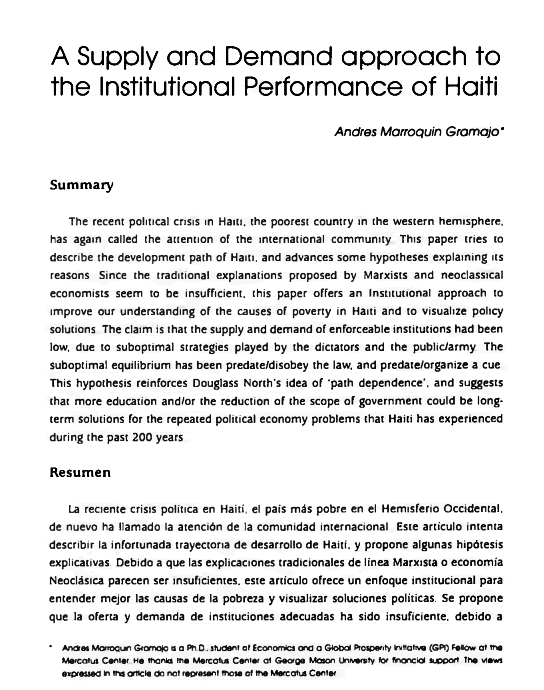A Supply and Demand approach to the Institutional Performance of Haiti
DOI:
https://doi.org/10.35319/lajed.20054268Keywords:
Institucionalism, HaitiAbstract
The recent political crisis in Haiti, the poorest country in the western hemisphere, has again called the attention of the international community. This paper tries to describe the development path of Haiti, and advances some hypotheses explaining its reasons. Since the traditional explanations proposed by Marxists and neoclassical economists seem to be insufficient, this paper offers an Institutional approach to improve our understanding of the causes of poverty in Haiti and to visualize policy solutions. The claim is that the supply and demand of enforceable institutions had been low, due to suboptimal strategies played by the dictators and the public/army. The suboptimal equilibrium has been predate/disobey the law, and predate/organize a cue. This hypothesis reinforces Douglass North's idea of 'path dependence', and suggests that more education and/or the reduction of the scope of government could be longterm solutions for the repeated political economy problems that Haiti has experienced during the past 200 years.
Downloads
References
Caprio, Giovanni. (1979) “Un livre de Mats Lundahl: Les paysans et la pauvrete: Une etude sur Haiti’, Le Nouveau Munde, Supplement du Dimanche, 5.
Crist, R. 1952. Cultural Dichotomy in the Island of Hispaniola. Economic Geography. Vol.28, No. 2: 105-121
Fass, Simon M. (1988.) Political Economy in Haiti: The Drama of Survival. New Brunswick, New Jersey: Transaction Inc.
Holcombe, Randal G. (2001.) Public Choice and Economic growth. In The Elgar Companion to Public Choice, edited by William F. Shughart II and Laura Razzolini. Massachusetts: Edward Elgar Publishing Inc.
Kryzanek, Michael J and Howard J. Wiarda. (1982) The Dominican Republic: A Caribbean Crucible. Boulder, Colorado: Westview Press.
Lundhal, Mats. (1983). The Haitian Economy: Man, Land and Markets. New York: St. Martin’s Press.
-----------. (1996). Income and Land Distribution in Haiti: Some Remarks on Available Statistics. Journal of Interamerican Studies and World Affairs, Vol. 38, No. 2/3, Special Double Issue: Poverty and Inequality in Latin America, 109-126.
North, Douglass C. (1990). Institutions, Institutional Change and Economic Performance. New York: Cambridge University Press.
Smith, Adam, An Inquiry into the Nature and Causes of the Wealth of Nations. Methuen and Co., Ltd. 1904. Ed. Edwin Cannan. Library of Economics and Liberty. 18 November 2003. <http://www.econlib.org/library/Smith/smWN17.html>.
Tullock, G. (1974.) The Social dilemma: The Economics of War and Revolution. Blacksburg: Center for the Study of Public Choice.






